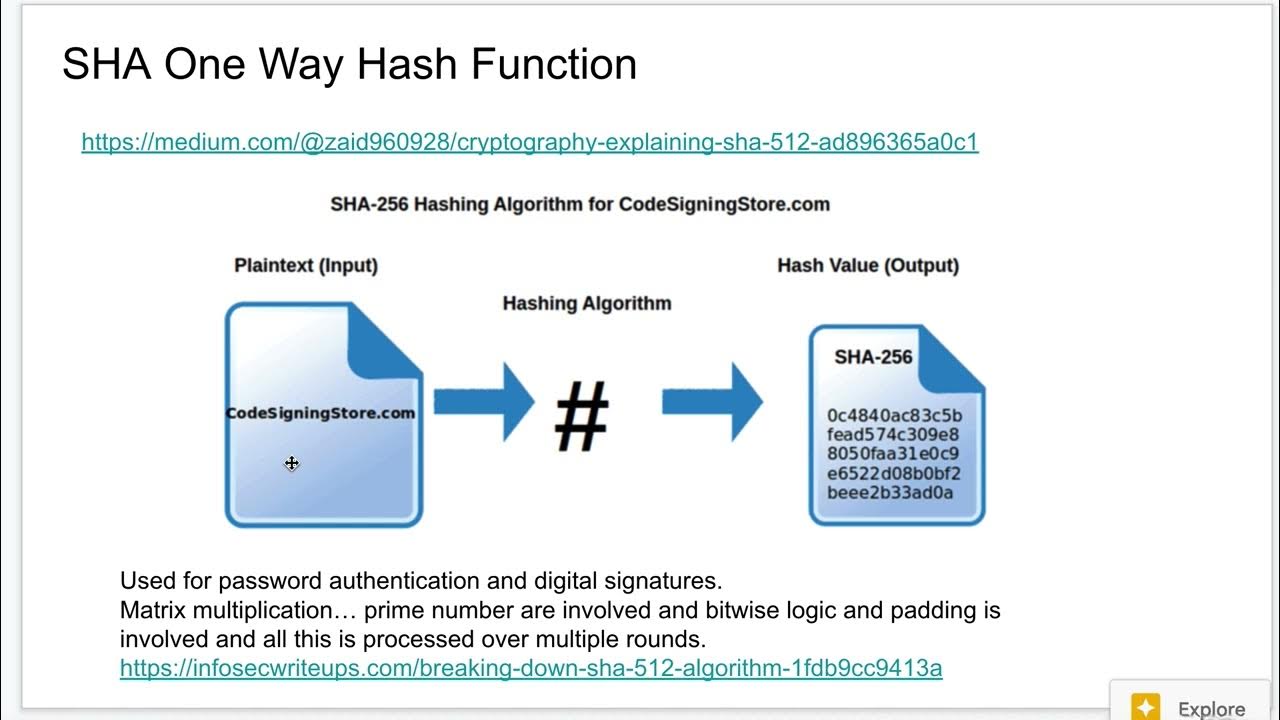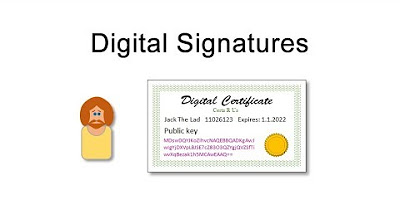Blockchain 101 - A Visual Demo
Summary
TLDRThis script offers a visual demonstration of blockchain technology, starting with the SHA-256 hash function as a digital fingerprint. It then introduces the concept of blocks, including a nonce to achieve a specific hash pattern, and explains the mining process. The script builds a blockchain, emphasizing its immutability and resistance to change, and illustrates how it can be used to track transactions of a token, ensuring the integrity of financial records.
Takeaways
- 🔒 The SHA-256 hash is a digital fingerprint of data that changes with even the slightest alteration in the input.
- 🔑 A hash is unique and consistent for the same data input, but it is computationally infeasible to predict the hash from the output alone.
- 📦 A block in a blockchain contains a block number, a nonce, and data, with the hash of the block including all this information.
- 🚫 The hash of a block must meet certain criteria (e.g., starting with four zeros) to be considered 'signed' or valid.
- 🔄 The nonce is a number used in mining to find a hash that meets the required criteria for a block to be valid.
- 🔑 Each block in a blockchain has a 'previous' hash that points to the hash of the previous block, creating a chain.
- 🔄 Changing data in any block will invalidate that block and all subsequent blocks because their hashes will change.
- 🛡️ Blockchain's immutability makes it difficult to alter past records without re-mining all subsequent blocks.
- 🌐 A distributed blockchain means that multiple peers hold identical copies, ensuring consensus and resistance to tampering.
- 💰 Blockchains can be used to track the transfer of tokens or currency, with each transaction recorded in a block.
- 💸 The coinbase transaction introduces new tokens into the system, similar to mining rewards in cryptocurrencies.
Q & A
What is a SHA-256 hash and how does it function as a digital fingerprint?
-A SHA-256 hash is a cryptographic hash function that produces a unique string of characters, which acts as a digital fingerprint for any given data. It changes with even the slightest alteration in the data, ensuring that the hash is unique to each specific set of data entered.
How does the hash change when you modify the data in the input box?
-The hash changes immediately with any modification to the data in the input box, reflecting the altered content and demonstrating its sensitivity to even the smallest change.
What is the purpose of a nonce in the context of a block in a blockchain?
-A nonce is a number used in the mining process to vary the hash of a block until it meets certain criteria, such as starting with a specific number of zeros. It is part of the trial-and-error process to find a valid hash for a new block.
Why is a block considered 'signed' in the blockchain demo?
-A block is considered 'signed' when its hash starts with a specific pattern, such as four zeros, which is arbitrarily chosen in the demo. This indicates that the block has been successfully mined and meets the required conditions.
How does changing information in a block affect the blockchain?
-Changing information in a block alters its hash, which in turn affects the 'previous' hash of the subsequent block, invalidating the chain of blocks from that point onwards. This demonstrates the integrity and immutability of the blockchain.
What is the process called when trying to find a number that results in a hash starting with four zeros?
-The process is called mining. It involves trying different nonce values until a hash that meets the criteria is found, which confirms the block and adds it to the blockchain.
How does the blockchain resist changes or tampering with its data?
-The blockchain resists changes because each block contains a hash of the previous block's data. Altering any information in a block would require re-mining not just that block, but all subsequent blocks, making it computationally impractical.
What is the significance of having multiple copies of the blockchain across different peers?
-Having multiple copies across different peers ensures the integrity and consensus of the blockchain. It allows peers to quickly verify the validity of the chain and detect any discrepancies, thus preventing tampering.
How does the concept of a coinbase transaction introduce tokens or money into the blockchain?
-A coinbase transaction is a special type of transaction that 'mints' new tokens or money out of thin air and assigns them to a specific entity, like Anders in the demo. This is the initial source of funds in the blockchain before any transactions occur.
Why is it important to track the provenance of tokens in a blockchain?
-Tracking the provenance of tokens ensures that each transaction is valid and that no money is created out of thin air. It allows for the verification of the history of each token and maintains the integrity of the currency.
What is the role of immutability in the context of a blockchain used for transactions?
-Immutability ensures that once a transaction is recorded in the blockchain, it cannot be altered or deleted. This is crucial for maintaining a reliable and trustworthy record of transactions, especially for financial transactions.
Outlines

Cette section est réservée aux utilisateurs payants. Améliorez votre compte pour accéder à cette section.
Améliorer maintenantMindmap

Cette section est réservée aux utilisateurs payants. Améliorez votre compte pour accéder à cette section.
Améliorer maintenantKeywords

Cette section est réservée aux utilisateurs payants. Améliorez votre compte pour accéder à cette section.
Améliorer maintenantHighlights

Cette section est réservée aux utilisateurs payants. Améliorez votre compte pour accéder à cette section.
Améliorer maintenantTranscripts

Cette section est réservée aux utilisateurs payants. Améliorez votre compte pour accéder à cette section.
Améliorer maintenantVoir Plus de Vidéos Connexes

One Way Hash Explained

Digital Signatures and Digital Certificates

Wie viele verschiedene Hashwerte gibt es für SHA-256? (Mit Datenspeicherung veranschaulicht)

What is a Cryptographic Hashing Function? (Example + Purpose)

🔴 Build Your Own Blockchain | How to Create a Blockchain? | Blockchain Tutorial | Simplilearn

Blockchain Technology Explained | Blockchain Technology Tutorial | Blockchain Tutorial | Simplilearn
5.0 / 5 (0 votes)
